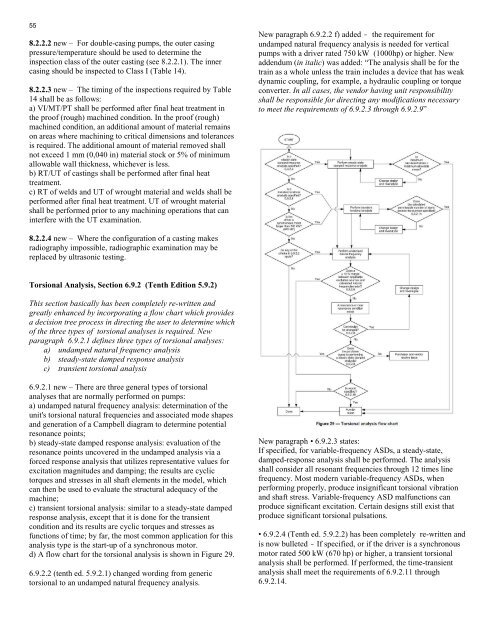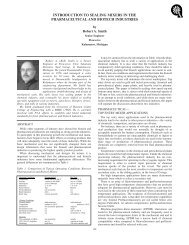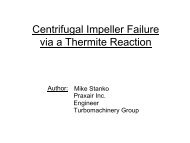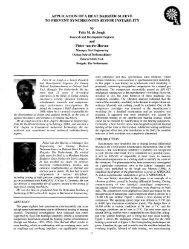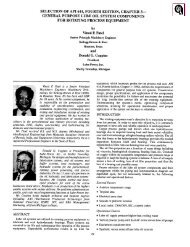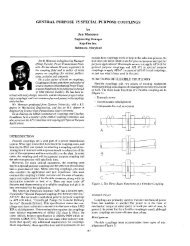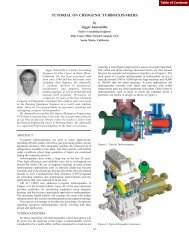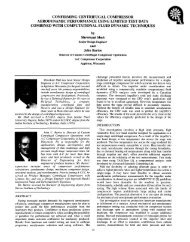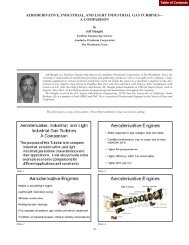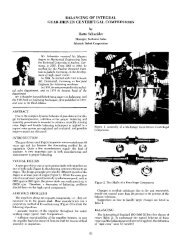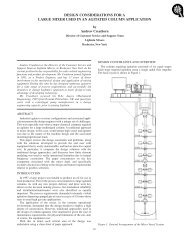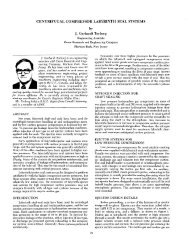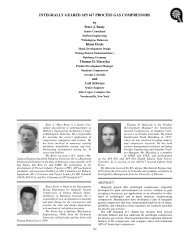ISO 13709 2nd Edition/ API 610 Eleventh Edition Highlights
ISO 13709 2nd Edition/ API 610 Eleventh Edition Highlights
ISO 13709 2nd Edition/ API 610 Eleventh Edition Highlights
Create successful ePaper yourself
Turn your PDF publications into a flip-book with our unique Google optimized e-Paper software.
55<br />
8.2.2.2 new – For double-casing pumps, the outer casing<br />
pressure/temperature should be used to determine the<br />
inspection class of the outer casting (see 8.2.2.1). The inner<br />
casing should be inspected to Class I (Table 14).<br />
8.2.2.3 new – The timing of the inspections required by Table<br />
14 shall be as follows:<br />
a) VI/MT/PT shall be performed after final heat treatment in<br />
the proof (rough) machined condition. In the proof (rough)<br />
machined condition, an additional amount of material remains<br />
on areas where machining to critical dimensions and tolerances<br />
is required. The additional amount of material removed shall<br />
not exceed 1 mm (0,040 in) material stock or 5% of minimum<br />
allowable wall thickness, whichever is less.<br />
b) RT/UT of castings shall be performed after final heat<br />
treatment.<br />
c) RT of welds and UT of wrought material and welds shall be<br />
performed after final heat treatment. UT of wrought material<br />
shall be performed prior to any machining operations that can<br />
interfere with the UT examination.<br />
New paragraph 6.9.2.2 f) added - the requirement for<br />
undamped natural frequency analysis is needed for vertical<br />
pumps with a driver rated 750 kW (1000hp) or higher. New<br />
addendum (in italic) was added: “The analysis shall be for the<br />
train as a whole unless the train includes a device that has weak<br />
dynamic coupling, for example, a hydraulic coupling or torque<br />
converter. In all cases, the vendor having unit responsibility<br />
shall be responsible for directing any modifications necessary<br />
to meet the requirements of 6.9.2.3 through 6.9.2.9”<br />
8.2.2.4 new – Where the configuration of a casting makes<br />
radiography impossible, radiographic examination may be<br />
replaced by ultrasonic testing.<br />
Torsional Analysis, Section 6.9.2 (Tenth <strong>Edition</strong> 5.9.2)<br />
This section basically has been completely re-written and<br />
greatly enhanced by incorporating a flow chart which provides<br />
a decision tree process in directing the user to determine which<br />
of the three types of torsional analyses is required. New<br />
paragraph 6.9.2.1 defines three types of torsional analyses:<br />
a) undamped natural frequency analysis<br />
b) steady-state damped response analysis<br />
c) transient torsional analysis<br />
6.9.2.1 new – There are three general types of torsional<br />
analyses that are normally performed on pumps:<br />
a) undamped natural frequency analysis: determination of the<br />
unit's torsional natural frequencies and associated mode shapes<br />
and generation of a Campbell diagram to determine potential<br />
resonance points;<br />
b) steady-state damped response analysis: evaluation of the<br />
resonance points uncovered in the undamped analysis via a<br />
forced response analysis that utilizes representative values for<br />
excitation magnitudes and damping; the results are cyclic<br />
torques and stresses in all shaft elements in the model, which<br />
can then be used to evaluate the structural adequacy of the<br />
machine;<br />
c) transient torsional analysis: similar to a steady-state damped<br />
response analysis, except that it is done for the transient<br />
condition and its results are cyclic torques and stresses as<br />
functions of time; by far, the most common application for this<br />
analysis type is the start-up of a synchronous motor.<br />
d) A flow chart for the torsional analysis is shown in Figure 29.<br />
6.9.2.2 (tenth ed. 5.9.2.1) changed wording from generic<br />
torsional to an undamped natural frequency analysis.<br />
New paragraph • 6.9.2.3 states:<br />
If specified, for variable-frequency ASDs, a steady-state,<br />
damped-response analysis shall be performed. The analysis<br />
shall consider all resonant frequencies through 12 times line<br />
frequency. Most modern variable-frequency ASDs, when<br />
performing properly, produce insignificant torsional vibration<br />
and shaft stress. Variable-frequency ASD malfunctions can<br />
produce significant excitation. Certain designs still exist that<br />
produce significant torsional pulsations.<br />
• 6.9.2.4 (Tenth ed. 5.9.2.2) has been completely re-written and<br />
is now bulleted - If specified, or if the driver is a synchronous<br />
motor rated 500 kW (670 hp) or higher, a transient torsional<br />
analysis shall be performed. If performed, the time-transient<br />
analysis shall meet the requirements of 6.9.2.11 through<br />
6.9.2.14.


